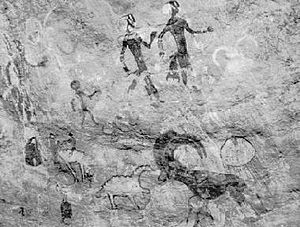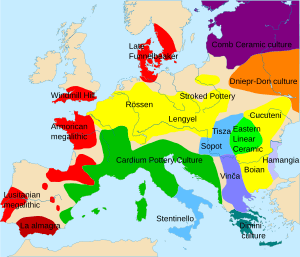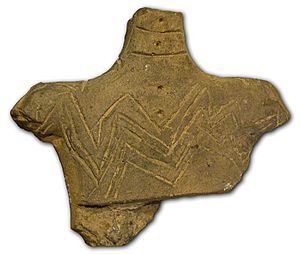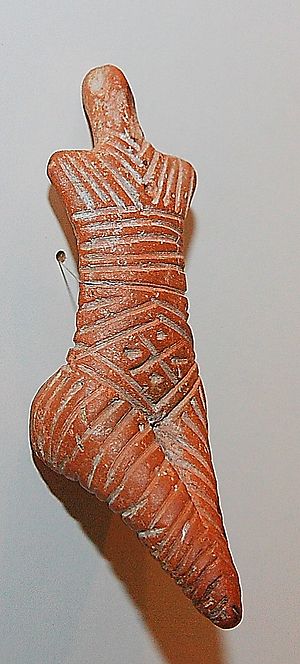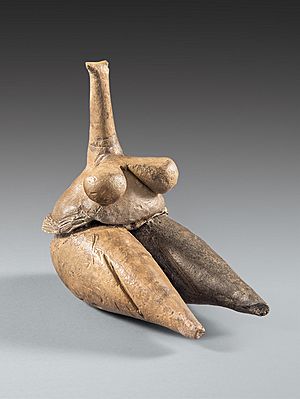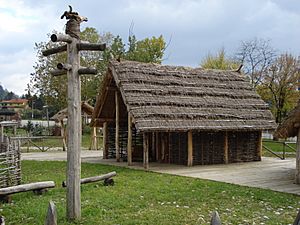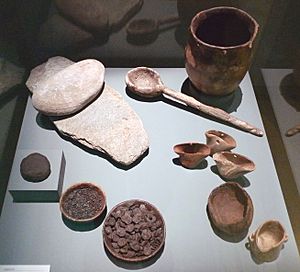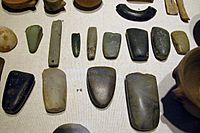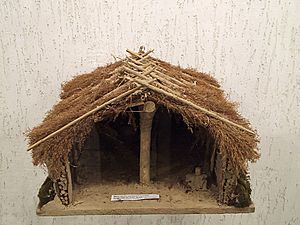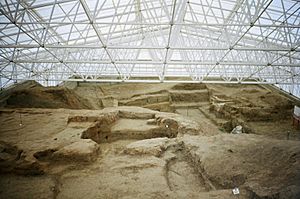Neolithic facts for kids
The Neolithic Age is the newest part of the Stone Age. The word "Neolithic" comes from two old Greek words that mean "new" and "stone."
This time period is famous because it's when farming was invented. People also started to care for animals like cows, sheep, and pigs.
The Neolithic Age didn't start at the same time everywhere. Different groups of people began farming at different times. After the Neolithic Age came the Bronze Age.
Contents
Where and When the Neolithic Age Happened
The Neolithic Age began at different times around the world. It often started in places where people first learned to farm.
Western Asia
The Fertile Crescent: Where Farming Began
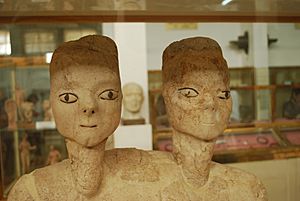
Around 10,000 BC, the first fully developed Neolithic cultures appeared in a region called the Fertile Crescent. This area includes parts of modern-day Lebanon, Israel, Palestine, Syria, Turkey, and Iraq.
One of the world's first towns, Jericho, appeared around 9000 BC. It had a stone wall and was home to 2,000 to 3,000 people. Another important settlement was Tell Qaramel in Syria, which had temples dating back to 9650 BC.
Southern Mesopotamia: Farming with Water
In the flat lands of Southern Mesopotamia (like Sumer), there wasn't much rain. So, people learned to use irrigation systems to bring water to their crops. The Ubaid culture, which started around 6,900 BC, was important here.
North Africa
Animals like sheep and goats were brought to Egypt from the Near East as early as 6000 BC. Some experts believe that farming in the Nile Valley developed locally, with people learning to grow crops or trading for them. Fishing, hunting, and gathering wild plants were still very important for food.
Europe
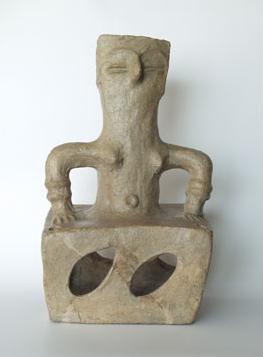

In southeast Europe, farming societies first appeared around 7000 BC. One of the earliest farming sites was found in Vashtëmi, Albania, dating back to 6500 BC. In Northwest Europe, the Neolithic Age started much later, around 4500 BC.
Early cultures in this area included the Sesklo culture in Greece and the Linear Pottery culture (also known as "Linearbandkeramik"). These farming traditions slowly spread across Europe through people moving and sharing ideas.
The Vinča culture in the Balkans might have created one of the earliest writing systems, called the Vinča symbols. However, archaeologists think these were more like pictures or ideas rather than a full writing system.
The Cucuteni-Trypillian culture built huge settlements in Romania, Moldova, and Ukraine between 5300 and 2300 BC. The megalithic temples of Ġgantija and Mnajdra on the island of Gozo (part of Malta) are famous for their giant stone structures, some built around 3600 BC. The Hypogeum of Ħal-Saflieni in Malta is a unique underground temple and burial place from around 2500 BC.
South and East Asia
The earliest Neolithic sites in South Asia are Bhirrana in India (7570-6200 BC) and Mehrgarh in Pakistan (6500-5500 BC). These sites show evidence of farming (wheat and barley) and keeping animals (cattle, sheep, and goats).
In South India, the Neolithic Age began around 6500 BC. In East Asia, early sites include the Nanzhuangtou culture (9500–9000 BC) and the Peiligang culture (7000–5000 BC).
Interestingly, in some very remote parts of West Papua (Indonesia), people still used polished stone tools like adzes and axes as recently as 2008! This shows how some Neolithic traditions lasted much longer in isolated areas.
In 2012, a new farming site was found in Munam-ri, South Korea, which might be the oldest farmland in East Asia.
The Americas
In the Americas, similar changes happened, like growing crops and living in one place. This started around 4500 BC, or possibly even earlier. However, these periods are usually called by different names, like the Formative stage or Archaic Era, instead of Neolithic.
The Formative stage in America is like the Neolithic Revolution in Europe, Asia, and Africa. In the southwestern United States, between 500 and 1200 AD, there was a big increase in people living in large villages. They grew crops like maize (corn), beans, and squash, and raised turkeys.
Australia
Australia generally didn't have a Neolithic period like other parts of the world. People there continued to live as hunter-gatherers until Europeans arrived.
How People Lived in the Neolithic Age
Social Life and Communities
For most of the Neolithic Age, people lived in small tribes. There isn't much proof of strong social classes in most Neolithic societies. People were generally more equal than in later times.
However, Neolithic societies were often more organized than the Upper Paleolithic cultures that came before them. The domestication of large animals around 8000 BC led to more differences in wealth in some areas. People who owned many animals could become richer.
Families and households were mostly independent. But, in Central Europe, early Neolithic people built large circular ditches between 4800 and 4600 BC. These structures needed a lot of time and work, suggesting that some important people could organize and lead others.
Some villages were even fortified with palisades (strong fences) and ditches. Evidence from sites like the Talheim Death Pit shows that fighting between groups was probably more common during the Neolithic Age than in the earlier Paleolithic period.
Homes and Settlements
Homes changed a lot from the Paleolithic to the Neolithic. In the Paleolithic, people didn't usually live in permanent buildings. But in the Neolithic, people started building mud-brick houses covered with plaster. Farming made it possible to live in one place.
Often, doorways were on the roof, and people used ladders to get in and out. The roof was held up by wooden beams. The ground inside was covered with platforms, mats, and animal skins for sleeping. Some settlements, especially in the Alps region, were stilt-houses built over water.
Farming and Food
A huge change in how humans lived was the development of farming. People stopped relying only on hunting and gathering. Instead, they started growing crops and raising animals. This meant they needed to stay in one place to tend their fields, which led to the growth of permanent settlements. This trend continued into the Bronze Age, leading to towns and then cities.
This big change is called the Neolithic Revolution. It was a term created by archaeologist Vere Gordon Childe in the 1920s.
One great benefit of farming was that people could produce more food than they needed right away. This extra food could be stored for later or traded. Living in one place and farming also meant populations grew faster than nomadic groups.
However, early farmers could also suffer greatly during famines caused by drought or pests. Their diet also became less varied, focusing on a few main crops and domesticated animals.
Living closer together and with animals also changed sanitation needs and how diseases spread.
Tools and Technology
The main feature of Neolithic technology is the use of polished or ground stone tools. This is different from the chipped stone tools used in the Paleolithic Age.
Neolithic people were skilled farmers. They made tools for planting, harvesting (like sickle blades), and processing crops (like grinding stones). They also made pottery and bone tools. But the most important tool for clearing forests for farming was the polished stone axe. With axes and adzes, they could shape wood for homes, structures, and canoes.
People in the Near East and Central Asia were also good builders. They used mud-brick to build houses and villages. At Çatalhöyük in Turkey, houses were plastered and painted with detailed scenes. In Europe, people built long houses from wattle and daub (a mix of sticks and mud). They also built elaborate tombs for the dead, especially in Ireland.
It was also important to find ways to keep food fresh, like making airtight containers and using salt.
People in the Americas and the Pacific islands mostly used Neolithic-level tools until Europeans arrived.
Clothing
Most clothing was likely made from animal skins. This is suggested by the many bone and antler pins found, which are perfect for fastening leather. Later in the Neolithic Age, wool cloth and linen might have become available. This is hinted at by perforated stones that could have been spindle whorls (for spinning thread) or loom weights (for weaving). The clothing worn by Ötzi the Iceman, who lived in the later Copper Age, might give us an idea of what Neolithic clothes looked like.
Famous Early Settlements
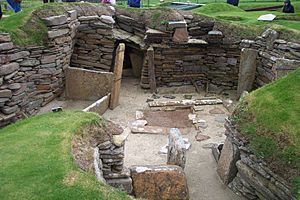
Here are some important early human settlements from the Neolithic Age:
- Göbekli Tepe in Turkey, around 11,000–9000 BC
- Guilá Naquitz Cave in Oaxaca, Mexico, around 11,000 BC
- Tell Qaramel in Syria, 10,700–9400 BC
- Jericho in the West Bank, Neolithic from around 8350 BC
- Aşıklı Höyük in Turkey, 8200–7400 BC
- Çatalhöyük in Turkey, 7500 BC
- 'Ain Ghazal in Jordan, 7250–5000 BC
- Mehrgarh in Pakistan, between 6500 and 5500 BC
- Khirokitia in Cyprus, around 7000–4000 BC
- Sesklo in Greece, 6850 BC
- Cucuteni-Trypillian culture settlements in Ukraine, Moldova, and Romania, 5500–2750 BC
- The Megalithic Temples of Malta, 3600 BC
- Knap of Howar and Skara Brae, Orkney, Scotland, from 3500 BC and 3100 BC
- Brú na Bóinne in Ireland, around 3500 BC
- Norte Chico civilization in Peru, 3000 to 1700 BC, with 30 settlements.
The world's oldest known engineered roadway, the Sweet Track in England, dates from 3800 BC. The world's oldest freestanding structure is the Neolithic temple of Ġgantija in Gozo, Malta.
Related pages
Images for kids
-
The Urfa Man, a statue from around 9000 BC, found in Şanlıurfa.
See also
 In Spanish: Neolítico para niños
In Spanish: Neolítico para niños


